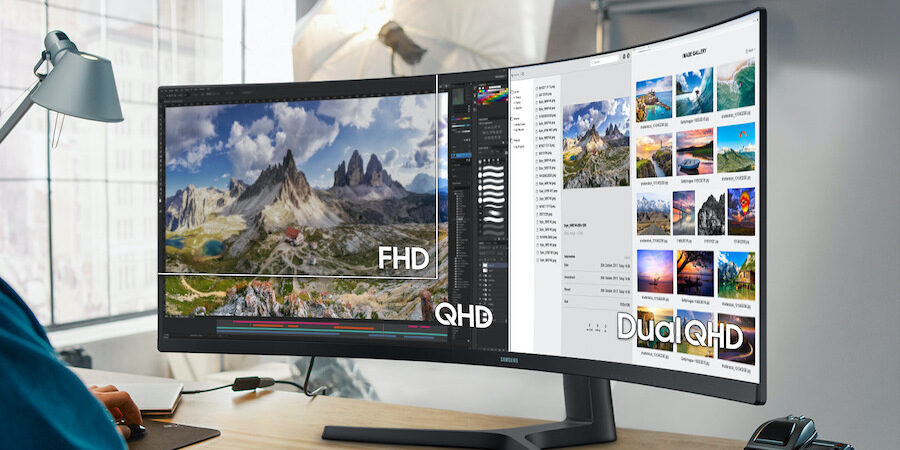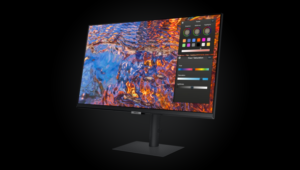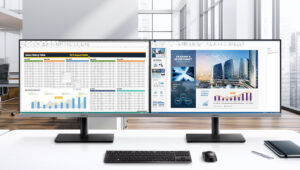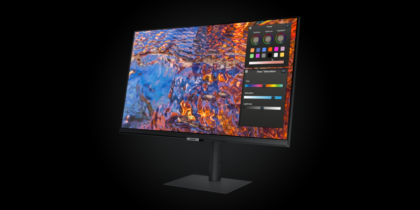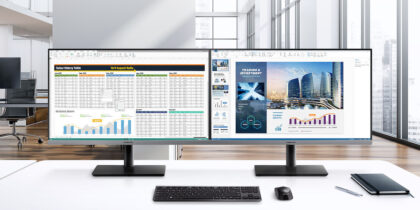When you spend most of your workday looking at a monitor, it’s more than a display; it’s a portal.
Just like every other technology with strongly practical applications, there are different types of desktop monitors best suited for different situations, circumstances and professions. One significant factor is screen resolution, or the number of pixels. Fewer pixels generally equates to less sharpness, but a lower-resolution monitor is often fine for certain use cases.
To help you make an informed decision, here’s a look at the three main types of monitor resolution:
What is an FHD monitor?
Full high-definition (FHD) monitors have 1920 x 1080 resolution. The total number of individual pixels on the monitor screen is therefore 2,073,600 (1920 x 1080), but this resolution is most often referred to as 1080p. FHD monitors such as the Samsung S40UA are relatively common because the image quality is acceptable for most needs.
Reimagine your offices for the hybrid workforce
Walk through the market drivers, societal shifts and technologies of the reimagined office in this free guide. Download Now
An FHD screen’s aspect ratio — or the ratio of screen width to screen height — is 16:9, the classic “widescreen” aspect ratio of most home TVs. By comparison, most movie theater screens have an aspect ratio of 21:9, which has a more pronounced widescreen effect.
What is a QHD monitor?
Quad high-definition (QHD) resolution is 2560 x 1440, for a total of 3,686,400 pixels — about 1.8 times the pixels of an FHD monitor. Images displayed on a QHD monitor will be sharper, better defined and more detailed, while still in the familiar 16:9 aspect ratio.
“Quad” in this context means four, because QHD is four times the resolution of the original high definition screens: 1280 x 720 (a total of 921,600 pixels).
What is a UHD monitor?
Ultra high-definition monitors have 3840 x 2160 resolution, for a total of 8,294,400 pixels. Maintaining a 16:9 aspect ratio, they promise ultra detail and sharpness on a screen of pretty much any size. UHD monitors are commonly known as 4K monitors, because 3840p resolution rounds up to 4000p.
Which monitor is best for you?
When comparing FHD versus QHD or UHD displays, the biggest differences are almost entirely about the screen resolution. The more pixels per inch (PPI), the greater pixel density, the crisper and more information-rich images appear.
You also need to ensure that your monitor’s cable connections will be able to carry the amount of information required for the screen’s full resolution. As long as that’s taken care of, it’s is simply a question of what monitor resolution best suits your needs.
Bear in mind, the advantages of a higher-resolution screen extend beyond the obvious gains in clarity, sharpness and detail levels. The higher the pixel count, the closer you can sit to the screen without suffering image degradation or eye strain. This is particularly useful for people who need to get up close to the information on screen, like designers or creatives or stock traders. But if your on-screen work is less concerned with the finest details, UHD may be an unnecessary expense.
The word “ultra” might suggest we’ve reached the pinnacle of monitor resolution, but Samsung knows otherwise. If a state-of-the-art monitor experience is paramount to your work, check out the extraordinary S95UA Series — a dual QHD, 49-inch monitor with a super-wide 32:9 aspect ratio and 5120 x 1440 resolution (7,372,800 pixels, double that of QHD). It’s also curved, so the entirety of the screen can be viewed at a glance and without eye strain. Samsung’s QLED screen technology provides an extraordinarily wide color palette, amazing peak brightness and incredible contrast. Its virtually borderless design means no distractions, and its swiveling stand adjusts for height, too.
Whether you need just enough detail or absolutely everything, there’s a Samsung monitor with the right dimensions and resolution to make your life easier.
Explore the full range of Samsung’s high-resolution desktop monitors that can help you work more effectively and accurately. And calculate the total cost of ownership (TCO) of upgrading your business’s monitors with five easy questions in this free assessment.
